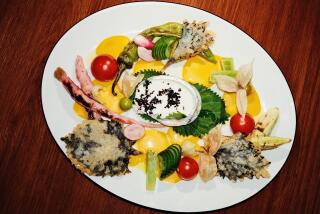In summer, Toronto the Good becomes Toronto the Even Better, thanks to its many patio drinking and dining options
- Share via
I can still see it, a dirty snowdrift with cigarette butts and a mitten frozen into it. It was one of my last sights before leaving Toronto one frigid February morning a decade ago to move to San Francisco. I’m generally glad to have left Toronto’s extreme, often histrionic weather.
There is one exception, though: I miss that first warm day of the year when a sense of fiesta sweeps through the city and locals swarm the city’s many patio bars.
As Toronto Life magazine’s restaurant critic Mark Pupo put it: “Even though it’s really too early, some people have shorts on. Everyone has found an excuse to leave work early. You see these pasty-faced neighbors you haven’t seen for months and you think, well, you’re still alive.”
It wasn’t until the 1960s that the first establishments with alfresco spaces opened here in the city formerly known as Toronto the Good, but they’ve since become something of a municipal obsession.
This summer Toronto licensed 720 sidewalk cafes, up nearly 10% in the last two years, and this figure doesn’t include backyard and rooftop patios.
The patio’s rise signaled the decline of Toronto the Good — Toronto the Staid and Stuck-Up — and the election of hard-partying Rob Ford as mayor probably banged the last nails into its coffin. This winter the City Council hastily shelved a draft proposal to increase taxes on places with patios, such is their popularity.
In the 1990s and early 2000s, when I lived here, there were a few patios, all cheap and cheerful, including the Diplomatico (the “Dip”) in Little Italy and a vast one attached to the anything-goes Black Bull Tavern on artsy Queen Street West.
Pupo said the city’s patios have become markedly more sophisticated. “You have the seasonal ingredients, the small plates, some thought — and money — invested in the design.”
For a trip this spring to my onetime home, I consulted with patio scenesters to devise a short list of new ones to try. I wanted ones in congenial, happening neighborhoods that would, together, give a visitor some sense of where the action is now in Canada’s largest city.
Sophisticated city
Temperance Street got its name in the Toronto the Good period, and the entrance to the Chase does feel speakeasy surreptitious: You walk down an alley, in an old building’s side door, up a freight-sized elevator and then, bam, there’s an elegant gray-and-white restaurant with a vast rooftop patio affording a panoramic view of the downtown’s towers. Highly recommended: the roasted octopus in salsa verde.
Brokers were trading war stories near us, and we had a clear view of the poor souls toiling in the new Deloitte office across the way.
June is thundershower month, and one drenched me on the way to a new midtown place that’s more play than work. Luckily, the patio at Madame Boeuf is fully covered, and its patrons can ignore the deluge and focus on their boccie games and burgers.
With its picnic tables and lawn chairs, this is a country cottage transported to the city, one of several places started by hipster restaurateur Anthony Rose at the northern edge of the Annex, a tree-canopied neighborhood full of brick Victorians.
At the Annex’s southern fringe on busy College Street, Bar Raval sounded the note of sophistication I had heard about.
Barcelona is its inspiration, with wood carved into Gaudí-esque curves within, patios for standing and sitting without, and a menu full of pintxos, the snacks on small plates that fuel the Catalan capital’s nightlife.
Also remarkable is the recently restored Distillery District, the best preserved set of Victorian factory buildings on the continent. On my way to a patio abutting its pedestrian-only cobblestone lanes, I watched a Hollywood production company shoot a big dance scene for “Little Italy,” an Emma Roberts-Hayden Christensen film being shot this summer in the city.
My destination, the Mexican El Catrin Destileria, has 140 tequilas and mezcals on offer and serves up deep-fried crickets for dipping in its guacamole.
I hopped on one of the bikes the city makes available for rental throughout downtown and cycled hard along the most Toronto of streets — Queen Street — to Ossington Avenue, a north-south artery in the West End that’s gotten busy and hip in my absence.
Strings of Edison bulbs illuminated the beer garden in front of the Bellwoods Brewery, a former auto repair shop in this area’s more utilitarian past. After the strenuous, somewhat sentimental journey across my old hometown, a cold brew with a hint of Ontario peaches in it went down easy.
One of Toronto’s prettiest new patios is attached to the Aga Khan Museum, a monumental building clad in white Brazilian granite, completed in 2010 in suburban North Toronto.
The museum, designed by Pritzker Prize-winning Japanese architect Fumihiko Maki and built at a cost of $300 million, exhibits art from across the Muslim world.
The heavens opened again the day I visited, so I could only admire the patio through a window, watching the rain pelt a stone floor so polished it reflected the light. Staff hastily removed the jewel-toned pillows from the outdoor couches.
It was more a museum than a patio day, so after sampling, indoors, from the restaurant Diwan‘s menu — Persian kufti meatballs and Moroccan mint tea — I toured the collection.
In an interview, the museum’s director, Henry Kim, a Korean American classics scholar, explained what drew him here from Oxford University’s Ashmolean Museum. “At this time in North America’s history, it’s important to have an institution here that represents the light, the beauty, the intellectual contributions made by the Muslim world.”
A golden astrolabe from 14th century Spain is a personal favorite: “It has Latin and Arabic inscriptions on it, scratchings in Hebrew. It speaks to a cross-cultural collaboration, to a pluralistic vision that is what the museum is about.”
Toronto’s other Drake
The Drake Hotel opened on Queen Street West in 2004. With a performance space in its basement, adventurous art throughout and a second-story patio, the Sky Yard, the hotel draws a louche, funky crowd.
A hub for the city’s creatives, this Drake’s nearest American analogs are the Bowery Hotel in New York and the Ace in downtown Los Angeles. It doesn’t resemble the grand Chicago hotel of the same name.
In June, Drake founder Jeff Stober opened a bakery-cafe and patio bar, the Drake Commissary, in the Junction, further confirming that West End neighborhood’s arrival.
Its old industrial buildings, as repurposed, now house artist studios, the outstanding Stephen Bulger photography gallery, and the Museum of Contemporary Art Toronto Canada. (The new train shuttle from the airport also stops there at Bloor Station.)
On the afternoon I visited, three Vespas were parked next to the patio. In this tarted-up pickle factory, I ordered an open-faced Danish-style smorrebrod sandwich with figs and duck-liver pâté on dark rye and a Queen Street Sour cocktail with some ingredients you expect in a sour (Canadian whiskey and lemon) and some you don’t (carrot, apple, turmeric and something called vegan foam).
As I drank outdoors in this once dry area, the city felt a far cry from Toronto the Good. The food was also a long way from the chicken wings and burgers served at the venerable, still-going-strong Black Bull Tavern.
On the drinks side, even the Black Bull has lately upped its game with craft brews aplenty on tap.
IF YOU GO
THE BEST WAY TO TORONTO
From LAX, Air Canada, WestJet and American offer nonstop service to Toronto; and United, Delta, American, Air Canada and WestJet offer connecting service (change of planes). Restricted round-trip airfare from $327, taxes and fees.
A train runs from the airport to downtown hub Union Station every 15 minutes from early morning to late at night. It costs $12 one way. Otherwise, cabs from the airport to the city cost about $55 pre-tip, and limos charge a flat rate of $60, again before gratuity.
WHERE TO STAY
Short-term rentals abound in Toronto — mainly they’re advertised through Airbnb.com. Congenial neighborhoods include Leslieville, Ossington and Queen West. A typical, mid-range offering: a well-appointed one bedroom in the historic, now-Bohemian Kensington Market area for just over $90 a night (U.S.).
Annex Garden Bed and Breakfast, 445 Euclid Ave.; (416) 258-1179. The hostess, a pug-owning professor, transformed her red-brick Victorian, steps from lively Little Italy, into an airy inn. An overnight in a suite starts at $150.
Drake Hotel, 1150 Queen St. W.; (416) 531-5042. A draw for local and visiting creatives, with its performance space and exhibits of avant-garde art. Its restaurant and second-story patio bar, are popular, see-and-be-seen, especially during the Toronto International Film Festival. Rooms ranging from tiny to mid-size start at $250.
WHERE TO DRINK AND EAT
Bar Raval, 505 College St.; (647) 344-8001.
Bellwoods Brewery, 124 Ossington Ave.; (416) 535-4586.
The Chase, 10 Temperance St.; (647) 348-7000.
Diwan, 77 Wyndford Drive; (416) 646-4677.
Drake Commissary, 128 Sterling Road; (416) 432-2922.
El Catrin Destileria, 18 Tank House Lane; (416) 203-2121.
Madame Boeuf, 252 Dupont St.; (647) 352-3337.
TO LEARN MORE
Toronto’s dining scene changes from one day to the next. Current information can be had from Toronto Life magazine, which features frequently updated restaurant reviews on its site. Each summer the local alt-weekly, Now magazine rates the newest patios on their drinks, snacks and ambience.
More to Read
Sign up for The Wild
We’ll help you find the best places to hike, bike and run, as well as the perfect silent spots for meditation and yoga.
You may occasionally receive promotional content from the Los Angeles Times.






